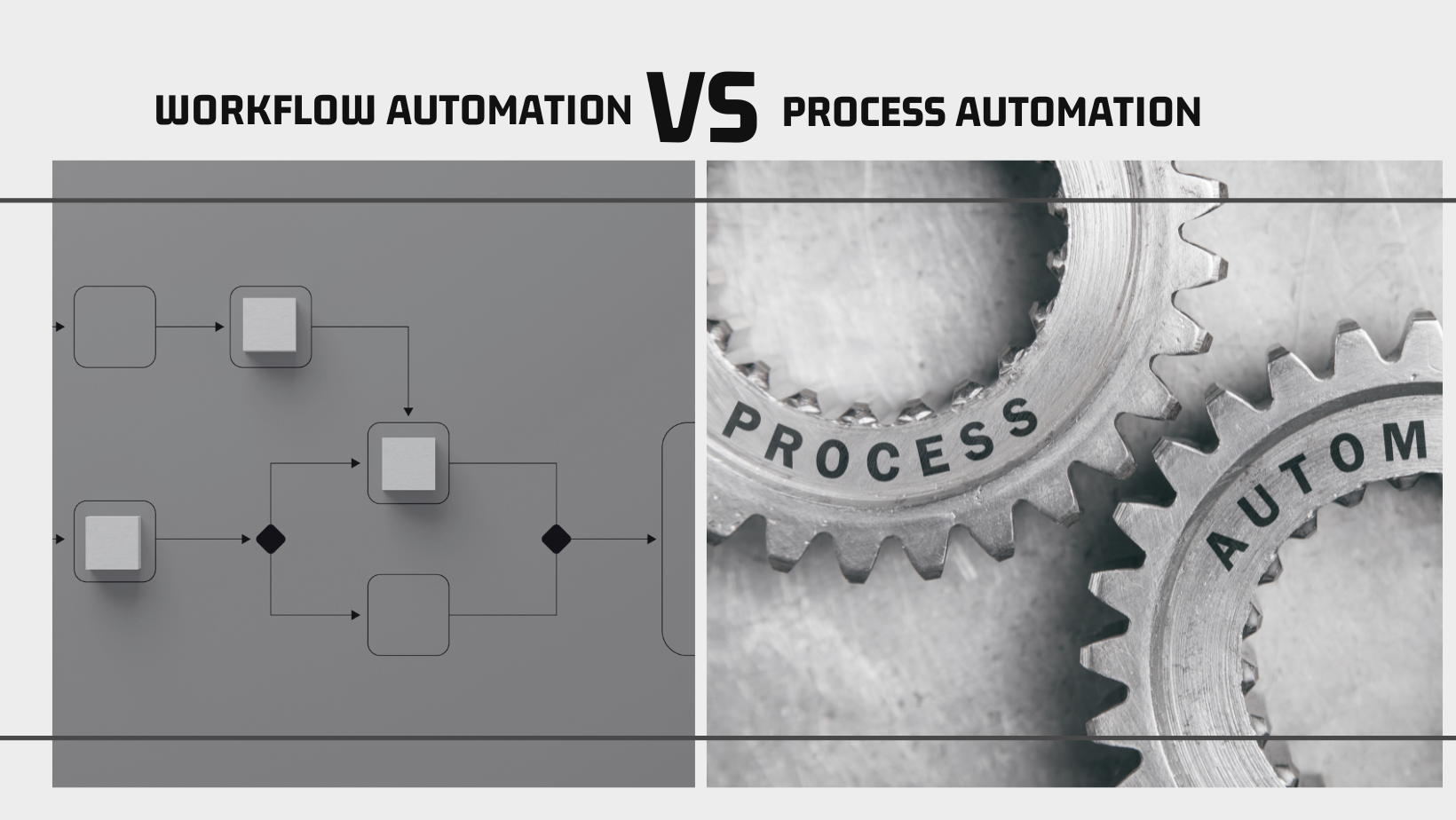The cornerstones of business success are simplified tasks, reduced manual intervention, and improved operations. The drive to achieve these parameters has led to the rise of automation as a solution to various problems faced by enterprises all around the globe. Two such types of automation that often intertwine but hold distinct purposes are workflow and process automation. While they share similarities, understanding their key differences is significant for the effective implementation and optimization of business operations. Let’s take a look at them!
What is workflow automation and what are its benefits?
Workflow automation refers to the sequence of steps, tasks, or activities necessary to complete a specific process or achieve a predefined goal. It outlines the chronological order in which tasks are executed and specifies the roles and responsibilities of individuals involved in the process. Workflows provide a visual representation of the entire process, highlighting dependencies, decision points, and approval mechanisms.
At its core, a workflow is a structured set of rules and procedures that guide the flow of work within an organization. It ensures that tasks are completed consistently and efficiently, minimizing errors and delays. Workflows are commonly used in various business functions such as project management, document approval, and customer support.
Benefits of workflow automation
Some key benefits of workflow automation include:
-
Increased Efficiency
Workflow automation eliminates manual tasks and streamlines processes, reducing the time and effort required to complete routine activities. By automating repetitive tasks, employees can focus on higher-value work, leading to increased productivity and output.
-
Improve Accuracy
Automation minimizes the risk of human error inherent in manual processes. With automated workflows, data entry mistakes, oversights, and inconsistencies are significantly reduced, leading to more accurate and reliable outcomes.
-
Improve Collaboration
Workflow automation facilitates seamless collaboration among team members by providing centralized access to tasks, documents, and project statuses. Team members can easily track progress, share updates, and collaborate in real-time, fostering better communication and teamwork.
-
Faster Turnaround Times
Automated workflows expedite the completion of tasks and processes by eliminating bottlenecks and delays. With predefined workflows and automated notifications, tasks move swiftly through the pipeline, reducing turnaround times and enhancing overall operational efficiency.
Understanding Process Automation
Process automation, on the other hand, involves the use of technology to automate repetitive, manual tasks and streamline complex business processes. It leverages software applications and tools to automate the execution of tasks, eliminating the need for human intervention and reducing the risk of errors.
Process automation aims to optimize the efficiency of business operations by automating routine tasks, freeing up valuable time and resources that can be allocated to more strategic activities. It enables organizations to standardize processes, enforce compliance, and improve overall productivity.
Benefits of process automation
As workflow automation, process automation offers some advantages that can revolutionize how businesses operate and improve overall efficiency. Here are four key benefits of process automation:
-
Improve Customer Experience
Process automation enables businesses to deliver faster response times and personalized interactions. By automating customer-facing processes such as order processing, support ticketing, and service delivery, organizations can improve customer satisfaction, loyalty, and retention rates. Automation also allows businesses to gather valuable customer data and insights, enabling them to tailor products, services, and experiences to meet customer needs more effectively.
-
Strategic Decision-Making
Process automation provides organizations with actionable insights and analytics to support strategic decision-making and business intelligence. By capturing and analyzing data generated by automated processes, businesses can identify trends, patterns, and opportunities for optimization and innovation. Automation enables stakeholders to make informed decisions based on real-time data, market trends, and performance metrics, driving continuous improvement and competitive advantage.
-
Cost Savings
Process automation reduces operational costs associated with manual labor, errors, and inefficiencies. By automating repetitive tasks, organizations can lower labor expenses, minimize the need for manual intervention, and optimize resource utilization. Additionally, automation helps mitigate the risk of costly errors, rework, and compliance violations, resulting in significant cost savings over time. By reallocating resources from repetitive tasks to higher-value activities, businesses can achieve greater efficiency and profitability while maximizing return on investment (ROI) from their automation initiatives.
-
Improve Accuracy and Consistency
Automation minimizes the risk of human error by ensuring that tasks are executed consistently and according to predefined rules and standards. By eliminating manual data entry and processing errors, process automation enhances data accuracy, integrity, and reliability, enabling organizations to make more informed decisions based on trustworthy information.
Key Differences: Workflow automation vs Process automation
While workflow and process automation are closely related concepts, they serve different purposes within the domain of business operations. The key differences between the two can be summarized as follows:
Scope
- Workflow automation focuses on defining the sequence of tasks and activities within a specific process.
- Process automation encompasses the broader concept of automating tasks and processes using technology.
Execution
- Workflow automation outlines the manual and automated steps involved in completing a process.
- Process automation automates the execution of tasks within the defined workflow, reducing manual intervention.
Flexibility
- Workflows can be customized to accommodate variations in processes and adapt to changing business requirements.
- Process automation provides scalability and flexibility by automating repetitive tasks and enabling process optimization.
Integration
- Workflows can be integrated with other systems and applications to facilitate data exchange and streamline information flow.
- Process automation integrates with existing systems and technologies to automate end-to-end business processes and enhance operational efficiency.
Scalability
- Workflow Automation is often suitable for departmental or team-level automation needs, where workflows are relatively small-scale and localized.
- Process Automation scales to enterprise-level requirements, capable of handling complex business processes spanning multiple departments, functions, and systems.
Customization
- Workflow Automation offers limited customization options, usually confined to configuring predefined templates or workflows.
- Process Automation provides extensive customization capabilities, allowing organizations to tailor automation solutions to their specific business requirements, including custom logic, rules, and integrations.
Workflow vs Process Automation: How do they work together?
While workflow automation focuses on the micro-level optimization of tasks, process automation operates at a macro-level, orchestrating the flow of work across different workflows and systems. Despite their distinct scopes, these two approaches are not mutually exclusive; in fact, they complement each other collaboratively.
Workflow automation serves as the building blocks for process automation, providing the foundation upon which end-to-end processes are constructed and automated. By automating individual tasks and subprocesses, organizations can standardize procedures, improve collaboration, and identify inefficiencies that can be addressed through broader process automation initiatives.
Moreover, process automation amplifies the benefits of workflow automation by enabling the perfect integration and orchestration of workflows across the entire organizational ecosystem. It ensures that data flows smoothly between disparate systems, applications, and departments, minimizing manual intervention and optimizing the end-to-end process flow.
Conclusion
While workflow and process automation are interrelated concepts, they serve distinct purposes inside your organization. Workflow defines the sequence of tasks and activities within a process, while process automation automates the execution of tasks to streamline operations and improve efficiency. By understanding the key differences between workflow and process automation, organizations can effectively leverage these methodologies to drive productivity, improve collaboration, and achieve their business objectives.
Both methodologies offer substantial advantages in terms of operational efficiency, productivity gains, and cost-effectiveness. However, the selection between these approaches ultimately hinges on the distinct requirements, goals, and intricacies of each organization.
The adoption of either workflow or process automation signifies a dedication to innovation and adaptability in an era characterized by ongoing digital transformation. Maximizing operational efficiency remains a central objective for sustainable growth and competitiveness in today’s business environment. By comprehending the capabilities of both strategies, businesses can strategically harness automation technologies to improve performance and realize transformative results in the pursuit of operational excellence.
Chakray’s team of experienced professionals can provide tailored solutions to ensure a great experience. Contact us today, and let one of our experts guide you through the process, and discover the full potential of it for your business.
Contact our team and discover the cutting-edge technologies that will empower your business.

Talk to our experts!





